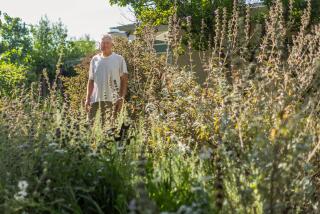Perfect Plants : Cacti and succulents require little maintenance, are easy to grow and don’t hit you too hard in the pocketbook.
- Share via
After knocking myself out in the garden during the long Memorial Day weekend, I decided there must be a way to maintain and enjoy a landscape without exacting a killing toll on my body and pocketbook.
Then I realized that keeping a traditional garden--with all the digging, mowing and weeding involved--must be especially tough on older people. For those who can afford to hire a gardener, it presents no problem. But many seniors are on a fixed income, while others who would like the relaxing and aesthetic pleasure of tending plants have space limitations.
I solved my problem by planting a drought-resistant array of cacti and other succulents in the patio garden. And tending and studying these plants is an ideal hobby for older people with physical, spatial, monetary, or time limitations.
“Succulents are a lot easier for older people to use in landscaping because they don’t have to be constantly beating the jungle back in order to enjoy a garden,” said Richard Bogart, owner of Desert Images, an Ojai nursery that specializes in cacti and other succulents.
“These plants are very forgiving of neglect or abuse,” he said. “And as people get used to the succulent, they find they enjoy their sculpture and individual qualities more and more.”
You may think they are too exotic, difficult to grow, or just plain boring. But in fact, these hardy plants propagate easily and have beautiful flowers. There are great variety and texture among spiny and smooth succulents. They can be grown in the ground, in pots or in hanging baskets. And in Mexico the smooth, fleshy pads of the opuntia cactus are boiled, scraped, diced into nopalitos, (“little cacti”) and eaten like string beans.
Bogart, who is 60, used his hobby to make a midlife career transition about 20 years ago.
“I was working in the engineering and survey field. And I wanted to get away from that into something I truly enjoyed doing.”
But for 74-year-old Thousand Oaks resident the Rev. Alfred Saez, professor emeritus of Spanish, collecting cacti has remained a passion and an avocation since he began teaching at Cal Lutheran University in 1964.
Saez’s passion extends to cacti growing in the wild, which should not be removed from their environment, he said. Many are on the endangered list after years of abuse by cactus rustlers. Nowadays cacti can be readily and inexpensively obtained from nurseries. And many enthusiasts, Saez said, trade plants that are easily propagated from seeds, cuttings or offsets (small plants that have formed around the parent plant).
He has more than 100 varieties of cacti in his garden.
“I don’t know why I like them,” Saez said. “Maybe because, like me, they look mean but they’re really harmless.”
Start-up costs are reasonable. Small succulents cost 50 cents to $6 each. And Bogart said most succulents can handle our climate, provided they get good strong light at least half the day.
“In general, all plants in small pots 6 inches in diameter and smaller would like some protection from the full-day sun,” he said.
When a succulent is grown in a pot, it requires a bit more water due to evaporation and drainage. When you first plant a cactus in the ground, Bogart suggests watering it every two weeks for its first year.
“As the roots get established in the second year, you can cut back to once a month, and decrease to three or four waterings during the third year,” he said.
“There is a lot more character to the succulent than in other types of plants where the main thing you see is the bloom and then it’s gone,” Bogart said. “And they are easier to take care of than a pet.”
CULTIVATING CACTUS
* Desert Images, 11140 N. Ventura Ave., Ojai, is open 10 a.m. to 4 p.m. weekdays and 9 a.m. to 5 p.m. weekends. For information, call 649-4479.
* Beginners will find the paperback Sunset book “Cactus & Succulents,” edited by Linda Brandt, very helpful. It is widely available in nurseries and garden stores for about $8.
* The Santa Barbara Botanic Garden offers free training in home gardening through its Master Gardener Program. Classes will begin Oct. 6 and will continue most Tuesdays 12:30 to 4:30 p.m. through March 16. Participants are chosen through an admission interview process. After completing the course, they are required to volunteer 80 hours on the Home Master Gardener Helpline as grounds staff, in community programs or in developing plant-related publications. For details, call 563-2521.
* Home gardeners in need of reassurance or free advice about bugs or matters botanical and horticultural can call the Master Gardener Helpline at 682-0988 from 1 to 4 p.m. Mondays and Fridays and 10 a.m. to 1 p.m. Wednesdays and Saturdays.






